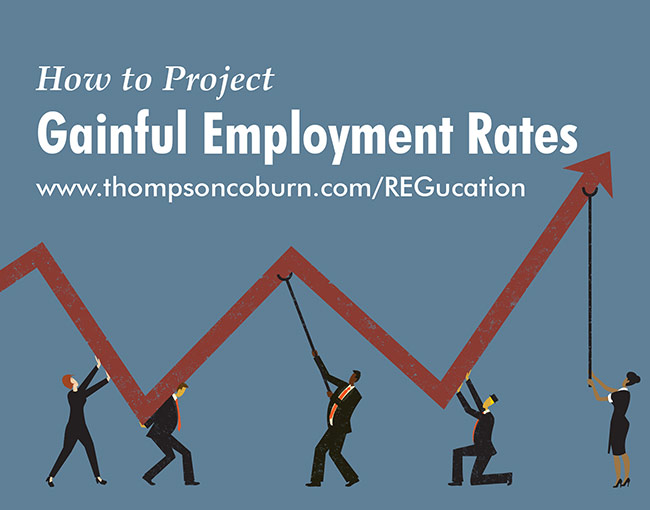By this point our Gainful Employment Series, you will have determined the scope of your institution and the programs that qualify as “GE Programs” (Part 1), created your student cohort (Part 2), and started calculating student debt (Part 3).
With this fourth post, we’ll continue our calculations and determine the average annual loan payment for students graduating from your GE Programs.
Step Seven: Amortization of the median loan debt to determine the annual loan payment
The final step in determining the numerator for your D/E rates is to amortize the median loan debt for each GE Program over a 10-, 15-, or 20-year repayment period. The credential level of the program determines the repayment period. A ten-year repayment period is used for programs that lead to an undergraduate certificate, a post-baccalaureate certificate, an associate degree, or a graduate certificate. Fifteen years is used for programs that lead to a bachelor’s degree or a master’s degree. And twenty years is used for programs that lead to a doctoral or first-professional degree. 34 C.F.R. 668.404(b)(2)(i).
When calculating D/E rates, the interest rate the Department will use to amortize the median loan debt will vary, depending on the length and type of program, as follows:
- For undergraduate certificate programs, post-baccalaureate certificate programs, and associate degree programs, the Department will use the average of the Federal Direct Unsubsidized Loan interest rate applicable to undergraduate students for the three-year period prior to the end of the cohort period.
- For graduate certificate programs and master’s degree programs, the Department will use the average of the Federal Direct Unsubsidized Loan interest rate applicable to graduate students for the three-year period prior to the end of the cohort period.
- For bachelor’s degree programs, the Department will use the average of the Federal Direct Unsubsidized Loan interest rate applicable to undergraduate students for the six-year period prior to the end of the cohort period.
- For doctoral programs and first professional degree programs, the Department will use the average of the Federal Direct Unsubsidized Loan interest rate applicable to graduate students for the six-year period prior to the end of the cohort period. 34 C.F.R. 668.404(b)(2)(ii)
By way of example, assume you were projecting the D/E rates for the 2014-15 award year for a bachelor’s degree program using a two-year cohort period, such that the applicable cohort period was award years 2010–2011 and 2011–2012. The repayment period would be fifteen years (because the credential level is a bachelor’s degree), and the applicable interest rate would be the average of the interest rates used for undergraduate Federal Direct Unsubsidized Loans for award years 2006–2007 through 2011– 2012 (i.e., the six-year period prior to the end of the cohort period).
It so happens that the interest rate for all undergraduate, graduate, and professional level Direct Unsubsidized Loans first disbursed between July 1, 2006, and June 30, 2013, was fixed at 6.8%. Thus, the average of the interest rates used for Federal Direct Unsubsidized Loans to undergraduates for award years 2006–2007 through 2011– 2012 is 6.8%.
Once you have determined the applicable repayment period and interest rate for each of your GE Programs, you will have all the data points you need to calculate each program’s Annual Loan Payment. Because students typically make monthly loan payments (not a single, annual payment), we’ll actually determine the monthly loan payment associated with each GE program, and then multiply the monthly payment by twelve to determine the Annual Loan Payment.
The monthly amortization formula, with associated values, is detailed below:
A = monthly loan payment
P = median loan debt for the GE Program
r = monthly interest rate (annual interest rate divided by 12)
n = total number of monthly payments (number of years for repayment multiplied by 12)
Because we appreciate that most institutions likely will use Excel, or some similar software, to carry out their GE calculations, we’ve set out below a spreadsheet-friendly version of the formula that you can use to calculate the Annual Loan Payment for your GE Programs (the formula calculates the monthly payment using the amortization formula above, then multiples the result by twelve).
Annual Loan Payment = 12*(D*((I/12)*((1+(I/12))^(Y*12)))/((1+(I/12))^(Y*12)-1))
The values included in this spreadsheet-friendly version of the formula are defined as follows:
D = median loan debt for the GE Program
I = annual interest rate
Y = number of years for repayment
Now let’s put it all together. If you are projecting the Annual Loan Payment for an undergraduate certificate program for the 2014-2015 award year, and the median loan debt for the program is $5,250, the values for your calculation would be as follows:
D = $5,250
I = 6.8%
Y = 10
When we input these values into the Annual Loan Payment formula above, we get the following equation:
Annual Loan Payment = 12*(5250*((0.068/12)*((1+(0.068/12))^(10*12)))/((1+(0.068/12))^(10*12)-1))
The calculation, once performed, yields an Annual Loan Payment of $725. We now have the numerators for our two D/E rate calculations, and are ready to move to the final steps of the projection process, which we'll cover in our fifth and final post in the Gainful Employment Series.
Looking for more information on the new Gainful Employment rules?
For a complete overview of the new gainful employment rules, including reporting, certification, and disclosure requirements, we invite you to listen in to our free gainful employment webinar series. Our next webinar, “Projecting Debt-to-Earnings Rates,” will take place Tuesday, December 9.
Aaron Lacey is a partner in Thompson Coburn’s Higher Education practice, and editorial director of REGucation. You can find Aaron on Twitter (@HigherEdCounsel) and LinkedIn, and reach him at (314) 552-6405 or alacey@thompsoncoburn.com.


















